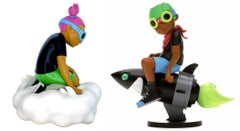Denial More Art
Canadian, b. 1976
Denial, also known as Daniel Bombardier, is a Canadian street artist known for his bold and satirical works that comment on consumer culture and the human condition. He was born on May 27, 1976, in Windsor, Ontario, Canada.
Denial's artistic practice is characterized by his use of iconic imagery and text, often re-appropriated in unexpected and humorous ways. His works feature recognizable brands and logos, altered to convey messages of social and political commentary.
Denial's works have been exhibited in galleries and museums around the world, including the Museum of Contemporary Art in Detroit and the Celaya Brothers Gallery in Mexico City. He has also created large-scale murals and public installations in cities across North America.
In addition to his work as a street artist, Denial is also an accomplished graphic designer and illustrator, creating album covers, posters, and merchandise for a variety of clients.
Denial's works continue to challenge and provoke audiences with their clever and irreverent approach to contemporary art and culture. He remains an influential figure in the street art movement, inspiring a new generation of artists to use their creativity to make a difference in the world.to
1
1
1
Overall Width
to
Overall Height
to
2
1
1
1
1
1
7
328
231
120
117
2
Artist: Denial
Chanel "Designer Drugs" Art Skate Deck
By Denial
Located in Draper, UT
Certificate of Authenticity Included
Edition Size: 50
SIZE 7.75 x 31 Inches
Archival Pigment Print Transfer on Cold Pressed Steep Natural Skate Deck
Category
2010s Denial More Art
Materials
Wood
DENIAL 100% Fuck You Can Sculpture Edition 100 Urban Street Contemporary Art COA
By Denial
Located in Draper, UT
DENIAL is a Canadian artist whose work critiques consumerism and the human condition. Though based in Windsor Ontario,
DENIAL spends much of the year travelling and exhibiting thro...
Category
2010s Street Art Denial More Art
Materials
Metal
$1,400 Sale Price
20% Off
Related Items
MOST IS WHAT YOU MAKE OF IT Sculpture Limited Edition of 75 With COA
By Kunstrasen
Located in Palm Desert, CA
"Most Is What You Make Of It" Sculpture by Kunstrasen x Silent Stage Gallery
Original White Online Exclusive Colorway
Edition of 75
Hand Casted in High Impact Resin
Fine Art Sculptu...
Category
2010s Street Art Denial More Art
Materials
Resin
$690
H 5 in W 9 in D 2 in
Hebru Brantley Flyboy Hebru Brantley Gaia set of 2 (Hebru Brantley art toys)
By Hebru Brantley
Located in NEW YORK, NY
Hebru Brantley GAIA (Hebru Brantley Lil Mama as Gaia) / Hebru Brantley FLYBOY: a set of 2 works:
Vinyl figures: 2 individual works. c.2017 (flyboy) & 2021 (gaia).
Gaia: 7.5 x 5.5 inches. Flyboy: 9 x 8 inches.
Each new, never displayed; accompanied by original packaging.
Published by Hebru Brantley from a limited series of unknown. Unsigned as issued.
Hebru Brantley Gaia:
Hebru Brantley’s ethereal art toy features his much iconic, Lil Mama character as Gaia, the fabled personification of Mother Earth. Wearing her traditional aviator goggles, Lil Mama glides on a cloud high above everyday life. Brantley has designed Gaia as an amulet that he says, will ‘…provide you and those you love with blessings and protection…’
Hebru Brantley Flyboy: Artist Statement:
"Flyboy came out of characters of colour within popular culture. I hate saying “popular culture,” but it’s really popular culture. I mean you look at cartoons. You’ve got animated sponges and ducks and birds and whatever, and it’s very rare to see a popular character within any medium that is African-American, Latino, even Asian.
What I wanted to do was create that, but in a space of high art and be able to have some historical context to that character. So I looked at the Tuskegee Airmen...
Category
21st Century and Contemporary Street Art Denial More Art
Materials
Vinyl
Hebru Brantley Gaia (Hebru Brantley Lil Mama as Gaia)
By Hebru Brantley
Located in NEW YORK, NY
Hebru Brantley GAIA (Hebru Brantley Lil Mama as Gaia):
Hebru Brantley’s ethereal art toy features his much iconic, Lil Mama character as Gaia, the...
Category
21st Century and Contemporary Street Art Denial More Art
Materials
Vinyl
Geisha Skateboard Triptych(suite of three silkscreen skateboards numbered 55/150
By Nobuyoshi Araki
Located in New York, NY
Nobuyoshi Araki
Geisha Skateboard Triptych, ca. 2014
Set of (3) Skateboards of Silkscreen on 7 ply Canadian Maplewood Deck
Signed in plate, Each signed on the deck and hand numbered ...
Category
2010s Contemporary Denial More Art
Materials
Wood, Maple, Screen
Rare Pink Apethoven Vinyl Adult Toy Ape Sculpture Bust SSUR Beethoven Medicom
Located in Surfside, FL
Artist: SSUR
Manufacturer: Medicom Toy
Type: Bust
Color: Hot Pink. (this also came in bronze and a glow in the dark fluorescent neon green)
Signed in the mold
Material: Vinyl sculpture
There is no box or bag.
Founded by visual and conceptual artist Ruslan Karablin...
Category
21st Century and Contemporary Street Art Denial More Art
Materials
Acrylic Polymer
$650
H 11 in W 7 in D 4 in
Hebru Brantley Flyboy (Hebru Brantley art toy)
By Hebru Brantley
Located in NEW YORK, NY
Hebru Brantley Flyboy Pop Art Sculpture / Hebru Brantley Beyond the Beyond, 2018. New in its original packaging.
Medium: Painted cast vinyl.
Dimensions: 9 x 8 x 4 inches (22.9 x 20...
Category
21st Century and Contemporary Street Art Denial More Art
Materials
Resin, Vinyl
Green Portrait with Struck-Through Text, Conceptual Figurative. Currency #268
By Natasha Lelenco
Located in FISTERRA, ES
This circular portrait combines vibrant green and violet tones with conceptual text intervention to explore identity, legibility, and symbolic erasure. Painted in acrylic on a round ...
Category
2010s Street Art Denial More Art
Materials
Wood, Acrylic
$282
H 0.99 in Dm 10.24 in
ROBOT Triptych (Set of Three (3) Skateboards), Long sold out Estate Authorized
By Jean-Michel Basquiat
Located in New York, NY
The Skateroom x Estate of Jean-Michel Basquiat
ROBOT Triptych (Set of Three (3) Skateboards), 2017
Set of 3 Silkscreens on 7-Ply Canadian Maplewood Skate Decks (Set of 3)
Estate of J...
Category
2010s Street Art Denial More Art
Materials
Wood, Maple, Mixed Media, Screen
Skateboard Skate deck (Blue) with COA hand signed by RETNA - Lt. Ed. of only 100
By RETNA
Located in New York, NY
RETNA
Skateboard Skate deck (Blue with wood back) with COA hand signed by RETNA, 2018
Silkscreen on Maplewood skate deck. Accompanied by Hand signed Certificate of Authenticity on Embossed Letterhead.
Limited Edition of 100
Separate embossed Certificate of Authenticity hand signed by RETNA
32 × 8 1/2 inches
Unframed
Limited edition of only 100 - not to be confused with similar looking skateboard from the larger edition of 250. This work is accompanied an embossed Certificate of Authenticity, issued by the sponsor "Beyond the Streets...
Category
2010s Street Art Denial More Art
Materials
Maple, Screen
$2,800
H 32 in W 8.5 in D 0.3 in
Inverted Monochrome Moldovan Portrait with Red Blue Circular Field. Currency 270
By Natasha Lelenco
Located in FISTERRA, ES
This inverted monochrome Moldovan portrait by Natasha Lelenco, part of her ongoing Exchange Currencies series (I’m Sorry, I’m Not From Here), is an acrylic painting on a circular pin...
Category
2010s Street Art Denial More Art
Materials
Wood, Acrylic
Signed Hebru Brantley Flyboy (Hebru Brantley art toy)
By Hebru Brantley
Located in NEW YORK, NY
Hebru Brantley Flyboy, 2018:
A rare example of this coveted Hebru Brantley Flyboy - signed, dated and inscribed on the outer packaging. New in its original packaging.
Medium: Painte...
Category
21st Century and Contemporary Street Art Denial More Art
Materials
Resin, Vinyl
Peace Fingers
By Shepard Fairey
Located in Dubai, Dubai
Peace Fingers
By Shepard Fairey
2023
Cream debosed epoxy resin
30.48 cm / 12 in height
Limited edition of 500
Category
2010s Street Art Denial More Art
Materials
Epoxy Resin
Denial more art for sale on 1stDibs.
Find a wide variety of authentic Denial more art available for sale on 1stDibs. If you’re browsing the collection of more art to introduce a pop of color in a neutral corner of your living room or bedroom, you can find work that includes elements of yellow and other colors. You can also browse by medium to find art by Denial in metal, screen print, wood and more. Much of the original work by this artist or collective was created during the 21st century and contemporary and is mostly associated with the street art style. Not every interior allows for large Denial more art, so small editions measuring 8 inches across are available. Customers who are interested in this artist might also find the work of Kid Hazo, Shepard Fairey, and Enzio Wenk. Denial more art prices can differ depending upon medium, time period and other attributes. On 1stDibs, the price for these items starts at $1,400 and tops out at $2,200, while the average work can sell for $1,800.
Artists Similar to Denial
Invader


